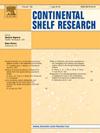Frontal features and mixing regimes along the shelf region of the Southern Benguela upwelling system
IF 2.2
3区 地球科学
Q2 OCEANOGRAPHY
引用次数: 0
Abstract
Mesoscale fronts are ubiquitous features in all Eastern Boundary Upwelling Systems and are the result of prominent sea surface temperature (SST) gradients and baroclinic jets. Their seasonal variability and presence can impact the horizontal mixing patterns of particles and nutrients. Here, we examine the role of alongshore fronts in shaping the seasonal patterns of cross-shore mixing, residence times, and surface particle transport along the shelf region of the Southern Benguela Upwelling System. Using a numerical ocean model together with a front-detection algorithm, Lagrangian particle tracking, and Finite Time Lyapunov Exponents, we investigate mesoscale frontal variability. In summer, fronts are typically long and continuous alongshore features that are defined by strong SST gradients and associated with prominent Lagrangian Coherent Structures (LCSs). These fronts can act as cohesive barriers that limit cross-shore mixing and offshore advection of particles. In winter, fronts are generally found further offshore and are more filamentous and numerous compared to summer. Furthermore, they are defined by weaker SST frontal gradients and shorter frontal lengths. Fronts in winter are not associated with any obvious LCSs, which implies that particles and material experience greater rates of dispersion and cross-shore mixing. Lagrangian float experiments confirm this and show surface particle trajectories in winter to be more variable and chaotic compared to the more uniform patterns observed in summer. Therefore, defined alongshore fronts in summer aid in the retention of particles on the shelf. The seasonal erosion of these defined frontal features allows for greater cross-shore mixing of particles, water masses and nutrients in the upper water column during winter.
南本格拉上升流系统陆架区锋面特征和混合机制
中尺度锋面是所有东边界上升流系统中普遍存在的特征,是海温梯度和斜压射流突出的结果。它们的季节性变化和存在会影响颗粒和养分的水平混合模式。在这里,我们研究了沿南本格拉上升流系统陆架区域沿岸锋在形成跨海岸混合、停留时间和表面粒子运输的季节性模式中的作用。利用数值海洋模型,结合锋面检测算法、拉格朗日粒子跟踪和有限时间李雅普诺夫指数,研究了中尺度锋面变化。在夏季,锋面通常是长而连续的沿岸特征,由强烈的海温梯度定义,并与突出的拉格朗日相干结构(LCSs)相关。这些锋面可以作为内聚屏障,限制跨海岸混合和离岸粒子平流。在冬季,锋面通常出现在离岸更远的地方,与夏季相比,锋面的丝状物更多,数量也更多。海温锋面梯度较弱,锋面长度较短。冬季锋面与任何明显的LCSs无关,这意味着粒子和物质经历了更大的分散和跨岸混合速率。拉格朗日浮子实验证实了这一点,并显示与夏季观察到的更均匀的模式相比,冬季的表面粒子轨迹更加多变和混乱。因此,在夏季,确定的沿岸锋面有助于保留大陆架上的颗粒。这些明确的锋面特征的季节性侵蚀使得冬季上层水柱中的颗粒、水团和营养物质有更大的跨岸混合。
本文章由计算机程序翻译,如有差异,请以英文原文为准。
求助全文
约1分钟内获得全文
求助全文
来源期刊

Continental Shelf Research
地学-海洋学
CiteScore
4.30
自引率
4.30%
发文量
136
审稿时长
6.1 months
期刊介绍:
Continental Shelf Research publishes articles dealing with the biological, chemical, geological and physical oceanography of the shallow marine environment, from coastal and estuarine waters out to the shelf break. The continental shelf is a critical environment within the land-ocean continuum, and many processes, functions and problems in the continental shelf are driven by terrestrial inputs transported through the rivers and estuaries to the coastal and continental shelf areas. Manuscripts that deal with these topics must make a clear link to the continental shelf. Examples of research areas include:
Physical sedimentology and geomorphology
Geochemistry of the coastal ocean (inorganic and organic)
Marine environment and anthropogenic effects
Interaction of physical dynamics with natural and manmade shoreline features
Benthic, phytoplankton and zooplankton ecology
Coastal water and sediment quality, and ecosystem health
Benthic-pelagic coupling (physical and biogeochemical)
Interactions between physical dynamics (waves, currents, mixing, etc.) and biogeochemical cycles
Estuarine, coastal and shelf sea modelling and process studies.
 求助内容:
求助内容: 应助结果提醒方式:
应助结果提醒方式:


